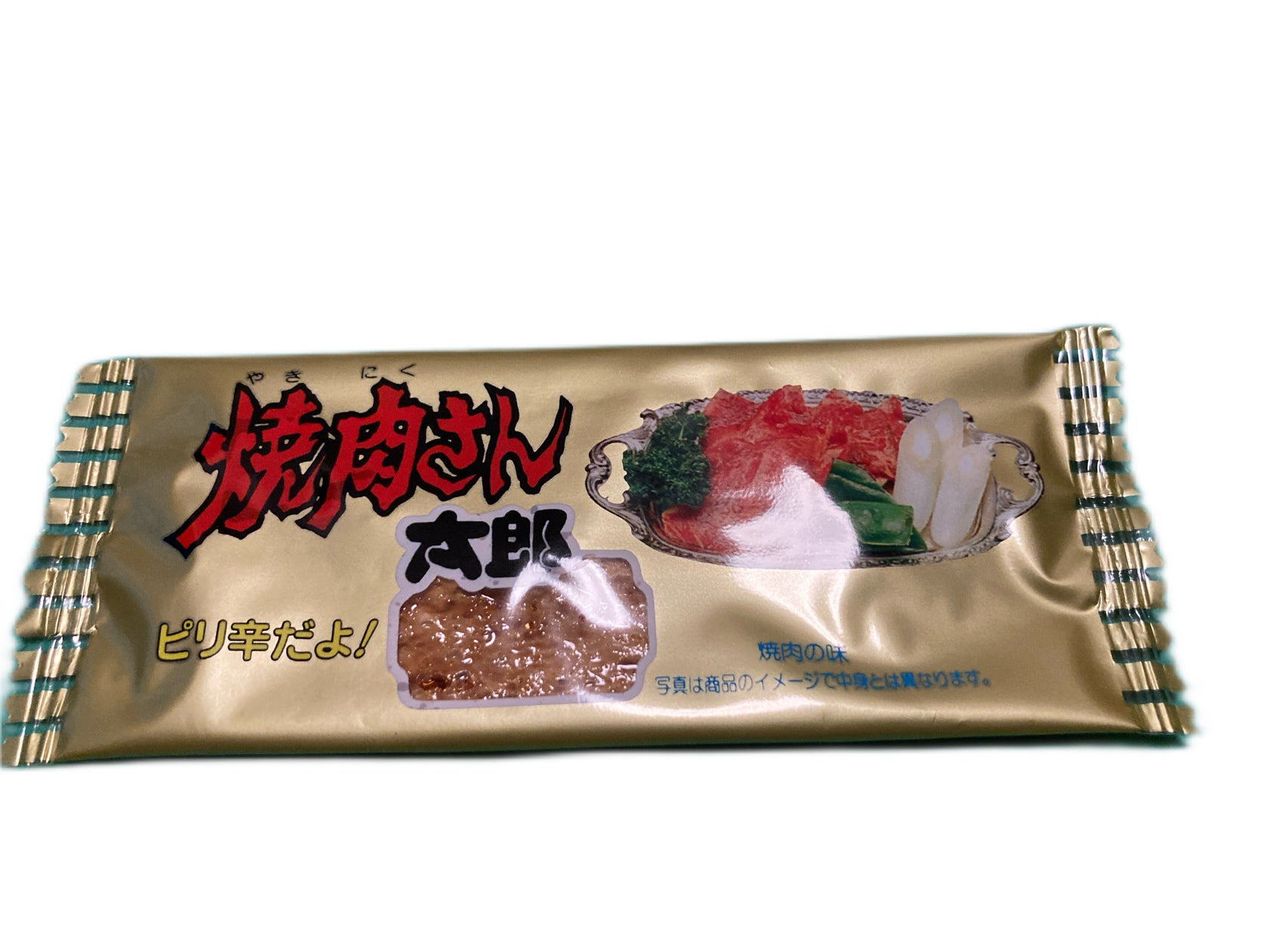There’s a snack that brings back memories of childhood with every bite. In Japan, dagashi (traditional, inexpensive candies and snacks) are something that almost everyone has tasted at least once. Among them, "Yakiniku San Taro" has been a beloved staple for generations, known for its unique sweet-and-savory flavor and crispy texture.


I remember eating this snack often as a child. Back then, a single piece of "Yakiniku San Taro" was only about 10 yen, making it an easy treat to buy in bulk from supermarkets or convenience stores. My friends and I would open the bags and enjoy them together while loitering in front of the store, or sometimes I’d receive it as a prize during neighborhood sports events. Even now, every bite of "Yakiniku San Taro" brings those vivid memories rushing back.
When you open the bag, you’ll first notice the slightly sticky surface and the aroma of soy sauce and mirin. While it’s called "Yakiniku" (grilled meat), it doesn’t actually contain any meat at all. Instead, it uses surimi, a paste made from fish like Alaska pollock, as the main ingredient. The surimi is coated in a barbecue-like sauce and grilled to create its unique taste and texture. Rather than evoking the taste of grilled meat, it’s more reminiscent of the sweet, rich flavor left at the bottom of a sukiyaki pot.

The slightly spicy kick gives it a different impression now that I’m an adult compared to when I was a child. I didn’t realize it back then, but when I bite into it now, I notice how surprisingly thin and firm it is. But this thinness is what gives it its distinct texture and makes you want to reach for "just one more" after each bite.

The dagashi culture has walked alongside Japanese children from the Showa era to the Heisei era, and now into the Reiwa era. Among these snacks, "Yakiniku San Taro" is one of the most popular items in the Taro Series, alongside "Kabayaki San Taro" and "Sudako San Taro." This series isn’t just a collection of snacks—it’s something that’s etched into the memories of generations of Japanese people. I’ll introduce Kabayaki San Taro and Sudako San Taro in another blog post.
Japan is known for its many traditional foods that reflect its seasonal changes and cultural heritage. For example, wagashi (traditional Japanese sweets) are crafted to express the beauty of nature and the changing seasons. In a similar way, dagashi also hold a certain nostalgic charm that’s deeply rooted in Japanese society. The packaging and taste of these snacks capture snapshots of life from the times they were created, allowing people to relive the past through these simple treats.
While the number of dagashi shops has decreased in recent years, these snacks are still quietly thriving in supermarkets and convenience stores, preserving their flavors and nostalgic charm. Their familiar, simple taste still resonates with many, including myself.
Although I don’t usually drink alcohol, I feel like "Yakiniku San Taro" would pair well with a drink. Putting a small piece in your mouth and chewing it releases the sweet-and-savory flavor, and as the taste spreads, it makes you linger in those fond memories of the past. Dagashi holds the power to "rewind time" and evoke cherished memories.
No matter how many pieces I eat, I always find myself wanting more. "Yakiniku San Taro" adds a touch of Japanese flavor and nostalgia to my daily life and will continue to be an irreplaceable part of my snack collection. I hope you’ll take a moment to enjoy its sweet-and-savory flavor.
| Category | Details |
|---|---|
| Ingredients | Surimi (fish paste) (fish, sugar) (produced in Japan), Wheat flour, Squid powder, Soy sauce, Mirin (sweet rice wine), Sugar, Spices, Seasoning (amino acids, etc.), Caramel coloring, Sorbitol, Sweeteners (stevia, licorice) |
| Nutritional Information (per piece) | - Calories: 10 kcal - Protein: 0.7 g - Fat: 0.02 g - Carbohydrates: 1.9 g - Salt equivalent: 0.2 g |
| Allergens | Contains wheat, squid, and soy. |
| Notes | Information is based on packaging and may vary due to product updates. Please check the package for the most up-to-date details. |
This table presents a clear overview of the ingredients, nutritional values, and allergen information for Yakiniku San Taro.



